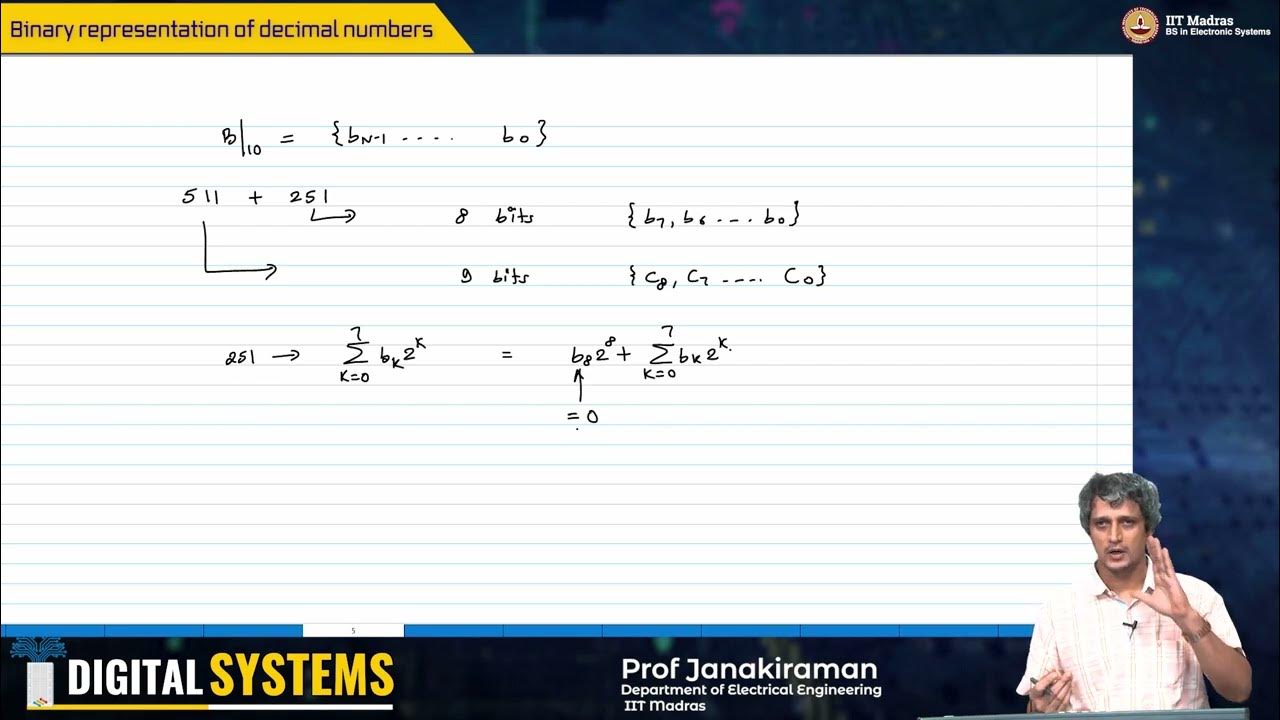Mengubah Bilangan Basis Desimal Menjadi Bilangan Basis Biner
Summary
TLDRIn this video, the presenter explains the process of converting decimal numbers to binary. They begin by clarifying that decimal (base 10) uses digits 0-9, while binary (base 2) only uses 0 and 1. The presenter demonstrates how to convert a decimal number like 20 into binary using successive divisions by 2, explaining each step and the resulting remainders. The process is further illustrated with the example of converting 175. The video concludes with practice problems for the audience to try, encouraging them to comment their answers. The presenter also invites viewers to like, comment, and subscribe for more math tutorials.
Takeaways
- 😀 Decimal (base 10) and binary (base 2) systems are explained at the beginning of the video.
- 😀 The decimal system uses 10 digits (0-9), while the binary system uses only two digits (0 and 1).
- 😀 To convert a decimal number to binary, divide the number by 2 and note the remainder (0 or 1).
- 😀 The division process continues until the quotient reaches 0.
- 😀 The remainders are written down and read from bottom to top to form the binary equivalent.
- 😀 An example conversion is shown with the decimal number 20, which converts to binary as 10100.
- 😀 Another example with the decimal number 175 is shown, which converts to binary as 10101111.
- 😀 Viewers are encouraged to practice by converting other decimal numbers like 45 and 1300 into binary.
- 😀 The video emphasizes the importance of understanding how to work with both decimal and binary systems.
- 😀 At the end of the video, viewers are reminded to like, comment, and subscribe for more math content.
Q & A
What is a decimal number system?
-The decimal number system is the standard number system we use, consisting of ten digits: 0, 1, 2, 3, 4, 5, 6, 7, 8, 9. It is based on the number 10, hence the term 'decimal'.
How is a binary number system different from the decimal system?
-A binary number system uses only two digits: 0 and 1. In contrast, the decimal system uses ten digits from 0 to 9.
Why do we need to convert decimal numbers to binary?
-Converting decimal numbers to binary is essential in computer systems and digital electronics, as binary is the base system used in computing and processing data.
What is the first step when converting a decimal number to binary?
-The first step is to divide the decimal number by 2. The quotient becomes the number for the next division, and the remainder is recorded as the binary digit.
What does the remainder represent when converting decimal to binary?
-The remainder represents the binary digit. As we divide by 2, each remainder (either 0 or 1) forms part of the binary representation of the decimal number.
Can you explain how to convert the number 20 into binary?
-To convert 20 to binary, divide it by 2 repeatedly, recording the remainders: 20 ÷ 2 = 10 (remainder 0), 10 ÷ 2 = 5 (remainder 0), 5 ÷ 2 = 2 (remainder 1), 2 ÷ 2 = 1 (remainder 0), 1 ÷ 2 = 0 (remainder 1). Reading the remainders from bottom to top gives 10100.
How do you handle the division when the result is 1 in the binary conversion process?
-When the division result is 1, divide it by 2. The quotient will be 0, and the remainder will be 1, which is the last binary digit before the division process ends.
How do you convert the decimal number 175 to binary?
-For 175, divide by 2 repeatedly: 175 ÷ 2 = 87 (remainder 1), 87 ÷ 2 = 43 (remainder 1), 43 ÷ 2 = 21 (remainder 1), 21 ÷ 2 = 10 (remainder 1), 10 ÷ 2 = 5 (remainder 0), 5 ÷ 2 = 2 (remainder 1), 2 ÷ 2 = 1 (remainder 0), 1 ÷ 2 = 0 (remainder 1). Reading from bottom to top gives 10101111.
What is the importance of the remainders in the conversion process?
-The remainders are crucial because they represent the individual binary digits (0 or 1) that make up the final binary number. They are collected in reverse order, from bottom to top.
Why do we stop dividing when the quotient becomes 0 in the binary conversion process?
-We stop dividing when the quotient becomes 0 because the binary representation is complete. At this point, all the necessary remainders have been recorded.
Outlines

此内容仅限付费用户访问。 请升级后访问。
立即升级Mindmap

此内容仅限付费用户访问。 请升级后访问。
立即升级Keywords

此内容仅限付费用户访问。 请升级后访问。
立即升级Highlights

此内容仅限付费用户访问。 请升级后访问。
立即升级Transcripts

此内容仅限付费用户访问。 请升级后访问。
立即升级浏览更多相关视频

CCNA - Converting Between Binary and Decimal Numbering Systems

How To Convert Binary To Decimal - Computer Science

Konversi Bilangan Biner ke Desimal - Cara Cepat dengan Rumus Tabel Konversi

W2_L2_Binary representation of decimal numbers

Binary Math - CompTIA Network+ N10-005: 1.3

KONVERSI BILANGAN BINNER
5.0 / 5 (0 votes)
